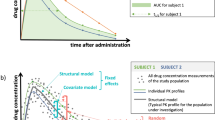Summary
Currently, there is an increasing focus on the implementation of pharmacokinetic-pharmacodynamic (PK-PD) studies and modelling as essential tools for drug development. Strategies involving specifically the population approach, which are based on relatively recent statistical methodology (e.g. nonlinear mixed effects modelling, NONMEM) have been advocated for investigating pharmacokinetic and pharmacodynamic variability as well as dose-concentration-effect relationships. The present article outlines this approach, and discusses how it can be implemented within the framework of the studies currently performed as part of the clinical phases of new drug development. It also considers study design and performance, based on real-life experiences.
Population approaches, if designed carefully and early, as part of the planning of the drug development programme, are expected to play a significant role at every phase of the programme and to contribute to providing information that is valuable for registration purposes. Statistical methodology and software are now widely available. However, practical issues such as integration of the population approach within existing protocols, quality control of the data, timing of laboratory and statistical analyses, as well as resource allocation, remain legitimate concerns to be considered in prospective studies.
Similar content being viewed by others
References
Balant LP, Roseboom H, Gundert-Remy UM. Pharmacokinetic criteria for drug research and development. Adv Drug Res 1990; 19: 1–138
Salmonson T, Rane A. Clinical pharmacokinetics in the drug regulatory process. Clin Pharmacokinet 1990; 18: 177–83
Peck CC, Harter J, Sanathanan L, et al. Simultaneous pharmacokinetic-pharmacodynamic modeling in drug development and registration. Proceedings of IUPHAR Satellite Symposium on Measurement and kinetics of in vivo drug effects. Noordwijk, The Netherlands: 1990; 28–9
Campbell DB. The use of kinetic-dynamic interactions in the evaluation of drugs. Psychopharmacology 1990; 100: 433–450
Kroboth PD, Schmith VD, Smith RB. Pharmacodynamic modelling: application to new drug development. Clin Pharmacokinet 1991; 20: 91–8
Sale ME, Blaschke TF. Incorporating pharmacokinetic/pharmacodynamic modeling in drug development are we ready? Drug InfJ 1992; 26: 119–24
Peck CC, Barr WH, Benet LZ, et al. Conference report: opportunities for integration of pharmacokinetics, pharmacodynamics, and toxicokinetics in rational drug development. Clin Pharmacol Ther 1992; 51: 465–73
Sheiner LB. Population approach in drug development: rationale and basic concepts. In: Rowland M, Aarons L, editors. New strategies in drug development and clinical evaluation: the population approach. Luxembourg: Commission of the European Communities, 1992; 13–29
Gundert-Remy U. Population approach in pharmacokinetics and pharmacodynamics — views within regulatory agencies: Europe. In: Rowland M, Aarons L, editors. New strategies in drug development and clinical evaluation: the population approach. Luxembourg: Commission of the European Communities, 1992; 153–6
Peck CC. Population approach in pharmacokinetics and pharmacodynamics: FDA view. In: Rowland M, Aarons L, editors. New strategies in drug development and clinical evaluation: the population approach. Luxembourg: Commission of the European Communities 1992; 157–168
Colburn WA, Olson SC. Classic and population pharmacokinetics. In: Welling PG, Tse FLS, editors. Pharmacokinetics: regulatory, industrial, academic perspectives. New York: Marcel Dekker 1988; 337–84
Bergman RN, Cobelli C. Minimal modeling partition analysis and the estimation of insulin sensitivity. Fed Proc 1980; 39: 110–5
Steimer JL, Vozeh S, Racine-Poon A, et al. The population approach: rationale, methods, applications in clinical pharmacology and drug development. In: Welling PE, Balant LP, editors. Handbook of experimental pharmacology. Vol 110: Pharmacokinetics of drugs. Heidelberg: Springer-Verlag, 1994; 405–51
Balant LP, Rowland M, Aarons L, et al. New strategies in drug development and clinical evaluation: the population approach. Commentary on an action for co-operative research. Eur J Clin Pharmacol 1993; 45: 93–4
Rowland M, Aarons L, editors. New strategies in drug development and clinical evaluation: the population approach. Luxembourg: Commission of the European Communities, 1992
Aarons L, Balant LP, Mentré F, et al. Population approaches in drug development: report on an expert meeting to discuss population pharmacokinetic/pharmacodynamic software. Eur J Clin Pharmacol 1994; 46: 389–91
Aarons L, Balant LP, Mentré F, et al. Practical experience and issues in designing and performing population pharmacokinetic/pharmacodynamic studies. Eur J Clin Pharmacol. In press
Sambol NC, Sheiner LB. Population dose versus response of betaxolol and atenolol: a comparison of potency and variability. Clin Pharmacol Ther 1991; 49: 24–31
Sheiner LB, Beal SL, Sambol NC. Study designs for doseranging. Clin Pharmacol Ther 1989, 46: 63–77
Van Bree J, Nedelman J, Steimer JL, et al. Application of sparse sampling approaches in rodent toxicokinetics: a prospective view. Drug Inf J 1994; 28: 263–79
Sheiner LB, Rosenberg B, Marathe VV. Estimation of population characteristics of pharmacokinetic parameters from routine clinical data. J Pharmacokinet Biopharm 1977; 5: 445–79
Ratain MJ, Schilsky RL, Conley BA, et al. Pharmacodynamics in cancer therapy. J Clin Oncol 1990; 8: 1739–53
Mentré F, Escolano S, Golmard JL, et al. Clinical pharmacokinetics of zidovudine: inter and intraindividual variability and relationship to long term efficacy and toxicity. Eur J Clin Pharmacol 1993; 45: 397–407
Holford NHG, Peace KE. Methodologic aspects of a population pharmacodynamic model for cognitive effects in Alzheimer patients treated with tacrine. Proc Natl Acad Sci 1992; 89: 11466–70
Holford NHG, Peace KE. Results and validation of a population pharmacodynamic model for cognitive effects in Alzheimer patients treated with tacrine. Proc Natl Acad Sci 1992; 89: 11471–5
Sanathanan L, Peck CC. The randomized concentration controlled trial: an evaluation of its sample size efficiency. Controlled Clin Trials 1991; 12: 780–94
Morselli PL. Effect of age on the dose-response curve. In: Lasagna L, Erill S, Naranjo CA, editors. Dose response relationships in clinical pharmacology. New York: Elsevier, 1989; 187–99
Sheiner LB, Rosenberg B, Melmon KL. Modeling of individual pharmacokinetics for computer-aided dosage. Comp Biomed Res 1972; 5: 441–59
Balant L, Gex-Fabry M, Balant-Gorgia A. The relevance of inter-ethnic differences for drug development and registration: implications for the design and interpretation of phase III clinical trials. In: Walker S, Lumley C, McAuslane N, editors. The relevance of ethnic factors in the clinical evaluation of medicines. London: Kluwer Academic, 1994; 201–17
Sheiner LB, Ludden TM. Population pharmacokinetics/pharmacodynamics. Annu Rev Pharmacol Toxicol 1992; 32: 185–209
Tanigawara Y, Hori R. Population approach in post-marketing dose adjustment. In: Rowland M, Aarons L, editors. New strategies in drug development and clinical evaluation: the population approach. Luxembourg, Commission of the European Communities 1992; 223–32
Balant LP. Blood-concentration measurements in clinical trials. Appl Clin Trials 1993; 2: 44–55
Beal SL, Sheiner LB. The NONMEM system. Am Statistics 1980; 34: 118–9
Linstrom MJ, Bates DM. Nonlinear mixed effects models for repeated measures data. Biometrics 1990; 46: 673–87
Mallet A. A maximum likelihood estimation method for random coefficient regression models. Biometrika 1986; 73: 645–56
Schumitzky A. Nonparametric EM algorithms for estimating prior distribution. Appl Math Comput 1991; 45: 141–57
Wakefield J, Smith AFM, Racine-Poon A, et al. Bayesian analysis of linear and nonlinear population models using the Gibbs sampler. Appl Statistics 1994; 43: 201–21
Mentré F, Gomeni R. A two-step iterative algorithm for estimation in nonlinear mixed effect models with an evaluation in population pharmacokinetics. J Biopharm Statistics 1995; 5: 141–58
Yuh L, Beal S, Davidian M, et al. Population pharmacokinetic/pharmacodynamic methodology and applications: a bibliography. Biometry 1994; 50: 566–75
Author information
Authors and Affiliations
Corresponding author
Additional information
The names of the authors are deliberatcly given in reverse alphabetical order.
Rights and permissions
About this article
Cite this article
Vozeh, S., Steimer, JL., Rowland, M. et al. The Use of Population Pharmacokinetics in Drug Development. Clin-Pharmacokinet 30, 81–93 (1996). https://doi.org/10.2165/00003088-199630020-00001
Published:
Issue Date:
DOI: https://doi.org/10.2165/00003088-199630020-00001




